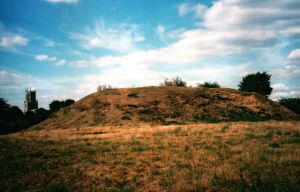Northampton’s prominence as the once home for the Royal Court, Royal Mint and for a short time a University, has been overtaken by time, but the importance of the town and county is reflected in some of the notable events that have taken place there. Although this is a study of Kings’ and Queens’ burials, I feel compelled to list some of the significant events to which Northampton and this County have been a witness:
- King Canute (1016-1035) takes as a ‘temporary’ wife, Aelfgigu, the daughter of the Earl of Northampton. He subsequently married Emma who bore him a son – Hardicanute (King – 1040-1042).
- Northampton railway station is on the site of the 12th century castle of which nothing remains (the ‘postern gate’ is a later reconstruction). But it was at the castle in 1164 that Thomas Becket had the worst of his rows with King Henry ii fleeing to London (via Becket’s Park and Becket’s Well) and into exile. Soon after his return from France in 1170, he was murdered at Canterbury Cathedral on 29th December.
- King Richard i grants Northampton its Charter in 1189 in return for funds for the Crusade.
- In 1211 King John’s long quarrel with Rome resulted in Pope Innocent iii sending ‘Pandulf’, his Papal Legate to excommunicate the King and read ‘The Instrument of Interdict’ prohibiting all Christian Rites and Services throughout the land. It was delivered and read to the King and his Court while they were at Northampton Castle. It was also at Northampton Castle that the Barons pressured King John to agree the Magna Carta.
- King Edward i decides to go on Crusade and ‘Takes up the Cross’ from the Papal Legate ‘Ottobuono Fieschi’ at Northampton Castle in June 1268.
- On the death of Queen Eleanor at Harbury, Lincolnshire, in 1290, King Edward i had her body taken to London for burial, erecting twelve ‘Eleanor Crosses’ at each place her body rested on the journey. Only three now remain of which one is in the County at Geddington and another in Northampton.
- Battle of Northampton. One of many during the ‘Wars of the Roses’, was fought ‘outside the walls’ on July 10th 1460 when King Edward iv captured King Henry vi. It took place between ‘Delepre’ Abbey (St Mary-de-le-Pre meaning St Mary in the meadow), and the River Nene at Nunn Mills Road. As part of Henry viii’s Dissolution, the Abbey was closed in 1538.
- In April 1464 Edward iv secretly marries Elizabeth Woodville at Grafton Regis (between Roade and Stony Stratford) thus igniting the fuse for Richard iii’s usurpation in 1483. King Henry viii added the suffix ‘Regis’ meaning ‘of the King’ in 1541.
- Richard iii was born at Fotheringhay Castle on 2nd October 1452. Mary Queen of Scots was beheaded at Fotheringhay Castle on 8th February 1587.
- ‘Princes in the Tower’. On the death of Edward iv, the new King Edward v and his brother, Richard of York, accepted the invitation of their Uncle Richard to travel down to London from Ludlow Castle. They stayed over in Northampton before resuming their journey to St Albans on 3rd May 1483. Edward of course was never crowned or heard of again.
- Peterborough. Never part of Northamptonshire (variously being ‘The Soke of Peterborough’ and now in Cambridgeshire) but difficult to exclude owing to its intrinsic connection as the County’s Diocesan Cathedral City. That allows me to include the tomb of Queen Katharine of Aragon who died in 1536 – first wife of King Henry viii.
- Naseby in 1645 was the site of the most decisive battle in the Civil War, the day being given to Oliver Cromwell’s troops after which King Charles i lost his throne and eventually his head. During his subsequent capture, and imprisonment, he was for a while in 1647 held at Holdenby House near East Haddon before being moved to Carisbrooke Castle on the Isle of Wight.
- Of more recent interest, and probably the only Royal to be buried in Northampton(shire), is Diana – Princess of Wales, who was laid to rest on the island in the middle of the lake at her family’s home – Althorp in 1997.
Above: Northampton Castle’s Postern Gate. Below: ‘Becket’s Well’ and Northampton’s ‘Eleanor Cross’.
The mound of rubble, which is all that remains of Fotheringhay Castle. A remnant of the castle’s masonry.
The plaques from left to right commemorate – the birth in the castle of King Richard iii in 1452; masonry from the castle keep protected by the Peterborough Archaeological Society; The beheading of Mary Stuart, Queen of Scots, in the Great Hall on 8th February 1587.






